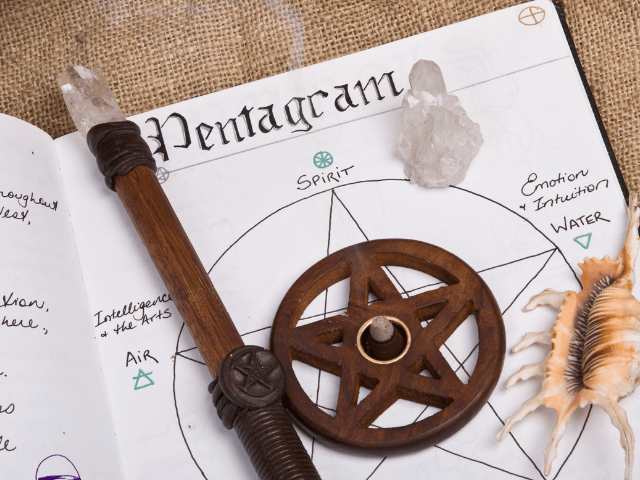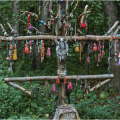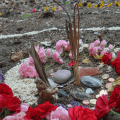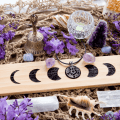Table of Contents
The change of seasons and motions of the weather play an important role in the Wiccan practices. The calendar is often thought of as a wheel, even being called the Wheel of the Year. This cylindrical motion of the heavens also plays a role in the astrology of Wicca. Since Wicca strives to commune with nature; it only makes sense to adhere to the seasons and work with them in your practice. Many astrological practices are popular in Wicca, but the main celestial bodies that are followed are the sun and moon. These two bodies have dramatic effects on the weather and seasons; so naturally, seasonal celebrations and full moon parties are common in Wicca.
In our society, the Gregorian calendar commands our work weeks and recreational days. This calendar is not in sync with the change of moon phases or other celestial bodies. This may cause timing issues for Wiccan celebrations, so get used to adhering to two different calendars. In Wicca, there are four main celebrations. These celebrations adhere to the equinoxes and solstices for the most part. There are also Sabbats that celebrate the full moons; new moons may have their own practices but are rarely celebratory. While many of the celebrations adhere to seasonal changes; there are other celebrations as well, such as Halloween, also known as Samhain.
Gerald Gardner, who popularized Wicca, used many English terms to name the celebrations; while other Wiccans prefer the Celtic names or simply call them what they are, such as ‘Harvest Festival;’ We also find German names of old pagan holidays, such as the equinoxes or solstices. Many Wiccan groups adhere to the same days to celebrate, organizing huge festivals where many different Wiccan groups come together. As we explore these holidays; keep in mind that the dates are not always the same for various Wiccan groups, especially in differing hemispheres. The chosen days are usually picked due to their astrological significance; you want to time festivals and parties in magically potent days.
Here is a loose list of the most popular Wiccan holidays:
- Samhain/Halloween
- Yule
- Imbolc/Candlemas
- Ostara
- Beltane/May Day
- Litha
- Lughnasadh/Lammas
- Mabon/Modron
Samhain (31 October in the Northern Hemisphere/2 May in the Southern Hemisphere)
Samhain is one of the most important holidays in the Wiccan calendar. It is based on an ancient Celtic festival celebrating the beginning of the New Year. During this time of year, the Goddess is seen as a crone, ancient and wise. It is also one of the two times of the year; when the veil that separates our world from that of the spirit realm is the thinnest. This allows for easier communication between the two worlds; and can allow spirits to cross over from their world into ours.
Samhain is also the third and final of the autumn harvest festivals; honoring the time of year when the productivity of the fields ends and the earth sleeps through the winter to recharge itself to be abundant again in the springtime. These associations make Samhain the perfect time of year for divination and for honoring the dead and your ancestors. It was traditional for feasts to be held to honor those who had crossed over into the spirit realm; complete with offerings of food, wine, and delicacies.
Your Samhain altar should be adorned with cloths and items in black, silver, and orange. It is common for photographs and mementos you possess from family and friends to be brought out at this time of year; and used to create a space to honor those who have passed on from this world. Some people choose to honor beloved pets and other companions in this way as well. Samhain is a powerful night for divination; so this would be the time to try asking any deep questions you have held and want answers to.
You may also consider trying a new divination practice or attempting the one you are not as experienced with. You should have better results on this night than most others. However, be sure to protect yourself from negative energies and entities; not all spirits who reach across the veil between worlds have your best interests in mind. This is also a good night for inner reflection and vision questing for personal enlightenment. You can use the more powerful energies and magic of this night to help further yourself along your magical path; and delve deeply into your soul and mind.
Yule (21 December in the Northern Hemisphere/21 June in the Southern Hemisphere)
Yule, also known as the Winter Solstice; is the day of the year when the night is the longest it will be. It marks the end of the dark half of the year and the rebirth of light into the world. Versions of this holiday are celebrated by many faiths and religions around the world; and many customs that are well-known; during Christmas festivals; and celebrations have their origin in Yule. This was done to try to convert pagans to the new monotheistic faiths; that were spreading during that time by blending the new ways with ancient; and familiar practices so that the new religions did not seem so alien.
Your Yule altar should be adorned with red, green, and white cloths and items. Sun symbols are appropriate to include since this festival celebrates the rebirth of the sun after the long night; and long winter. It was a tradition for a large bonfire to be lit and kept burning all night to help encourage the sun to rise; and end the longest night of the year. You can bring a smaller version of this into your home with a Yule log; which can either be the first log thrown onto the fire to get it started or by taking a log and decorating it with candles that you keep lit all night if you don’t have space to light a fire in.
This was also the time of year when the Holly King; who later became Santa Claus, gave over the rule of the earth to his brother, the Oak King; to signal the beginnings of new growth and the end of the deep sleep of winter. This is a time to spend with friends and family; giving thanks for the gifts of the year and each other. This is where the customs of giving gifts and sending holiday cards originated. Hanging a bough of mistletoe above the main door to your home on this day is thought to bring you luck; if you leave it there until the following year.
Imbolc (2 February in the Northern Hemisphere/2 August in the Southern Hemisphere)
Imbolc is sometimes also known by the name Candlemas. It is a celebration of the very first signs of the coming spring in the middle of winter. This is a time of year of purification and renewal; where the seeds of the next year’s crop are planted and nurtured through the final days of snow and cold. This holiday is sacred to the Celtic goddess Brighid, who is a goddess of healing, poetry; and crafting (usually smithcraft or heart crafts). During this time of year, the Goddess is seen as a young maiden, blossoming with youth and vitality. This is a day filled with feminine energy; and focused on the divine female that lives within every one of both sexes. This is a day to light candles; and surround yourself with fresh flowers to bring in the light; and fresh spring energy the world is beginning to blossom with.
For Imbolc, your altar should be adorned with cloths and items in white, pink, and red. These colors are associated with Brighid and represent some of the first colors seen during the budding spring. This is a good time of year for cleansing and purification; which is where the idea of spring-cleaning rituals for your home comes from. For Imbolc, you should consider cleansing your magical tools and ritual space to get rid of the energies of the old year; and invite in the fresh energies of spring and the promise of growth. Consider making a Brighid’s wheel to hang in your home.
These are sometimes known as God’s eyes; and are a fun and simple craft you can do to honor the Goddess. Along with cleaning your magical space and tools, this is a good day to do some personal “housekeeping” as well. Spend some time meditating on your life and the direction it is heading in; and begin the process of cleaning out any unwanted habits, thought patterns, or ways of life to make room for new ones; that will bring you closer to your goals and help you heal the hurts you carry with you.
Ostara (21 March in the Northern Hemisphere/21 September in the Southern Hemisphere)
Ostara, also known as the Spring Equinox, marks the official start to spring; and is one of the two days of the year when light and dark are equal. This even split between night; and day helps bring balance to the magical energies associated with this time of year as well. Ostara is a day of abundance and fertility. This is when livestock and animals in the wild begin to give birth to their young and the seeds; that were started at Imbolc are planted in the fields. Ostara is also the source of many of the customs and traditions associated with Easter; like the connections that exist between Yule and Christmas. This holiday celebrates new growth in all forms in Nature and of a personal sort.
Your Ostara altar should be decorated with pastel colors of any variety you like; representing the budding flowers and the new growth that can be seen in the world. This is also an appropriate time to display fertility symbols, such as eggs, rabbits, and flower blossoms. Consider making your own Ostara eggs; and decorating them with images and words that remind you of the things you want to grow; and nurture over the coming year. Your personal workings during this day should focus on planting the seeds of things you would like to grow inside yourself over the course of the next year.
This can be new habits you would like to form, pursuing a new path in work, education; or hobbies, or spending time developing and “growing” a trait within yourself that you want to nurture. This is also a wonderful day to harness the power of spring; and growth to start a magical herb garden for use in your spells and rituals. Make sure to take time to spend in Nature to enjoy the blossoming spring and renewal that comes with Ostara. This can be as simple as taking a leisurely stroll through your local park to listen to the birds. What matters is getting out of the house; and reconnecting with the green world that has been sleeping throughout the winter and is starting to awaken.
Beltane (2 May in the Northern Hemisphere/31 October in the Southern Hemisphere)
Like Samhain, Beltane is a powerful day of magic and the other time of year when the veil between our world; and the spirit realm is at its thinnest. However; instead of the energies of death and sleep after the harvest like we experience with Samhain, Beltane is a day of growth; abundance, and renewal. It is a day when fairies are thought to dance in groves in the woods and work their benevolent mischief in our lives and our magic.
You can invite the fairies into your home and your life to increase the vitality found within yourself; but do so with caution since they also bring more than a little chaos with them! This is not always a bad thing since it can lead to unexpected paths and developments but can be uncomfortable; if you are not prepared for things to be stirred up. Beltane is also a fire festival, igniting the passions sparked by the fertility of Ostara; and anticipating the heat of the coming summer. It is a day of passion, love, and even of lust; where vigor and energy return to the world and to the sun.
Adorn your Beltane altar with cloths and items in red; and gold to celebrate the warmth, passion, and light of this time of year. This is the day when dancing of all forms should be your go-to form of movement. Dancing lights helps encourage heat and passion within yourself and hearkens to ancient customs of dancing around the Beltane bonfire and around the Maypole. Maypoles can still be found in some celebrations on this day.
Dancers wearing bells around their ankles weave in between one another; while weaving colorful ribbons around the pole itself, which is a symbol of masculinity and fertility. This is the day to celebrate the Goddess; and God uniting before the Great Marriage of Litha, so weavings, braids; and other methods of conjoining materials should be featured. This union ensures the continuation of life into the next year. As Beltane is a fire festival, try to include fire into your altar and sacred space as much as possible. If you cannot have a full fire, light candles and place them all over your sacred space.
Litha (21 June in the Northern Hemisphere/21 September in the Southern Hemisphere)
Litha is also known as the Summer Solstice or sometimes as Midsummer. This is the day of the year with the longest period of daylight and the shortest night. Since this is the day when the sun is at the zenith of its strength and power; Lithia is also the day of the Great Marriage between the Goddess and the God; the union between masculine and feminine energy in the world and in all living things.
During this time of year, all of Nature is exploding with abundance and growth before the first harvest comes. The Goddess is seen in her mother aspect, full of life; and ensuring the continuation of all living things through her. Lithia is also when the Oak King hands over control of the year to the Holly King since after this day the sun loses power and we begin to enter the dark half of the year.
Your Litha altar should be adorned with cloths and items in gold, blue and green. Green magic and the power of herbs and herbal remedies is at its strongest on this day. This is one of the best times to begin cutting your own magical herb garden if you have one or to go searching for wild herbs out in Nature so that you can bring some of this abundance and power into your magical workings.
Likewise, this is a good day to begin infusing oils; for creating incense blends or making magical baths to use during the coming year, as anything that includes green magic in its workings will be especially strong when crafted this day. If you can, stay up to watch the sun rise on the longest day of the year. Honor the day of fullest light by keeping a fire burning all day. If you can’t have a full fire, keep a candle lit to honor the sun; and the light of the day. Spend the day outside in Nature and enjoy the warmth, abundance, and light that fill the solstice. Hold any rituals you may have planned or plan to cast spells at noon when the sun is at its peak in order to take full advantage of its strength and power.
Lughnassadh (2 August in the Northern Hemisphere/2 February in the Southern Hemisphere)
The first of the three harvest festivals of the year is known as Lughnassadh, or sometimes as Lammas. While this holiday falls during the height of summer when the days are usually at their warmest; it is also when the crops begin to hit full ripeness and can start being gathered. This usually begins with grain crops like wheat; so it is traditional for sacrifices or offerings of wheat and other grains to be made to ensure an abundance throughout the following harvests in order to have enough to last through the winter to the following spring. It is a day sacred to the Celtic god Lugh, who is a god of the sun and of crafts.
Your Lughnassadh altar should be adorned with cloths and items in harvest colors of gold, yellow, and brown. Spend the day doing things like baking bread to make use of the fresh wheat that was traditionally available for flour at this time of year. This is also when you should start harvesting your own personal projects and workings. The seeds you planted in yourself at Imbolc and Ostara are becoming ripe just like the crops in the field; so make sure you start to bring them in as well. Take some time to meditate on the progress you have made over the course of the year.
Are you on track for where you wanted to be? Have you experienced any unexpected challenges, and if so, how did you handle them? What can you do to make sure your personal harvest at the end of the year is the fullest and most abundant it can possibly be? By taking stock of these things now; you can use the magic of this day of harvest to make the most of your year and personal projects.
This is a time when your personal power is going to be at its height, so it is a good time to work any spells or personal charms you have been wanting to cast. It is also a good time for infusing magical jewelry or crystals with energy since this is when Nature is ripe and full of abundance that can be stored in your crystals for later use in other workings during the dark parts of the year.
Mabon (21 September in the Northern Hemisphere/21 March in the Southern Hemisphere)
Mabon is the second and primary harvest festival and is also known as the Autumn Equinox. This is the second time during the year when there is an equal amount of light and darkness in the course of the day. But unlike the Spring Equinox, Mabon signals the beginning of autumn and the strengthening of darkness within the year. All things in Nature begin down the path to their long sleep of hibernation during the cold, dark winter. But before that happens, Mabon provides an occasion to celebrate the bounty of the earth and of the harvest and is a time to give thanks for what has grown since the beginning of spring.
On Mabon, you should adorn your altar with cloths and items in autumn colors like brown, deep red, orange, and mustard yellow. Be sure to include plenty of nature symbols like acorns, pinecones, and especially ears of corn and sheaves of wheat. Mabon is sometimes called the Witch’s Thanksgiving since it celebrates the largest harvest of the year. This is a good time to give offerings of vegetables, grain, and nuts to the Goddess, the God, and the spirits of Nature in thanks for the magical power and energy they have provided for you during the year for your spells and rituals.
Mabon is also a time to begin preparing for the darkest part of the year. It is a day to rest and give thanks in the middle of what is usually a very busy time bringing in the harvest. This rest time is usually a time for deep inner spiritual workings and for reflection on a personal level. By spending time thinking about what you have harvested from the seeds you planted in the spring, it provides a platform for you to begin thinking about what you want to do with that personal harvest and what new seeds you may want to plant in the following year. Be sure to include your magical workings in your harvest. Gather up your charms, spells, and tools to reflect on the magic you want to work and how your personal magical practice has progressed over the course of the year.






 I love to write books about alternative religion, occult, and spirituality. My books are written for everyone in an easy to read and understandable style.
I love to write books about alternative religion, occult, and spirituality. My books are written for everyone in an easy to read and understandable style.